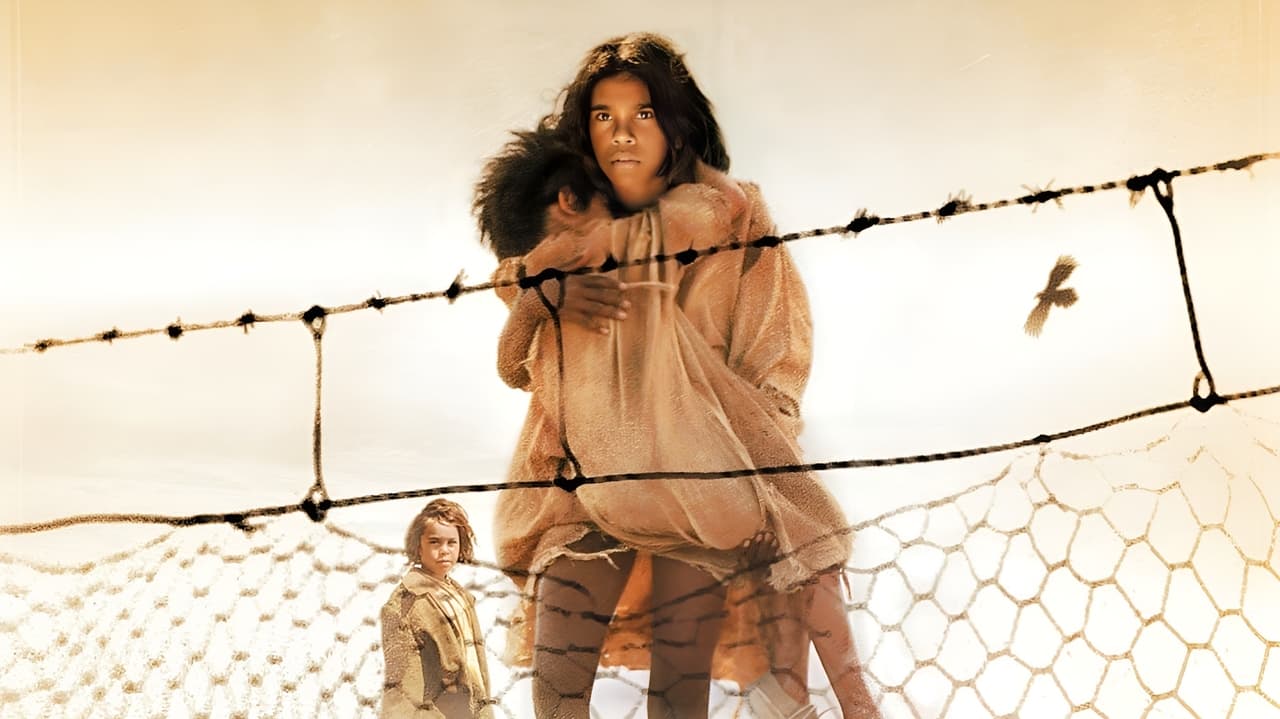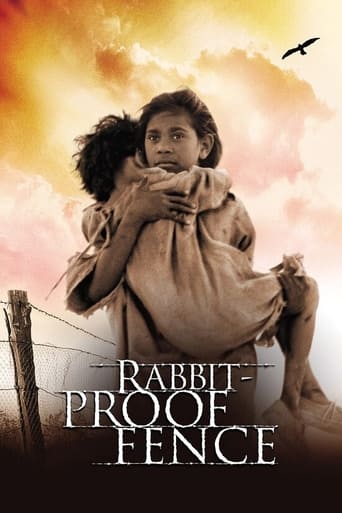

Rabbit-proof Fence (2002) is a story of three young girls who were from their homes was for "ethnic cleansing" purposes by the protagonists. Called "half-caste" children, they were considered a type of third race, and science was unable to do DNA and blood tests so they backed their reasoning by showing photographs of different generations of 'breeding out' the native aboriginal blood. After escaping from Moore River, a dormitory resembling a compound, they are tracked by a professional tracker and outsmart him, an ironic twist in the fact that they were taken from home to isolate the dark-skinned "less intelligent" girls from the rest of society. Two girls make the long journey, and even after returning home, they escape with their mother into the desert where the antagonist Molly is eventually caught and returned to the camp. When I first started watching this film, I thought perhaps the girls were being stolen for slavery purposes. The constables who led the search for the girls justified their morals by saying they were doing this for the children's own good, and to help society by reabsorbing the aboriginals back into "white" culture (where the lightest skinned children were spared from the grim dormitory lifestyle for real schools because they were supposedly more likely to succeed). In the 1930's Australia was still suffering major debts and depression after WWI. In "Culture And Customs of Australia", author Laurie Clancy says:"Farmers were forced off their land, city-dwellers were evicted from their homes and often took to the road in search of subsistence. Shanty towns grew up, with police constantly moving vagrants along." Women with children were considered a financial debt, and children "an unnecessary burden." (p. 29)This explains why there was nobody willing to stand up for these children, although they do meet sympathetic strangers along the way. Another thing I learned from researching the history of Australia is that the children who became survivors still struggle with cultural identity and family issues. They are known as the "Stolen Generation". This film was comparable to "12 Years A Slave" where actor Solomon Northup is drugged and sold into the black market as a slave, regardless of the fact that he has his papers declaring him a free man. The first time we see his character cry is for someone else; in Rabbit-proof Fence the eldest girl Molly (still a baby herself at 12 years old) cries only after the first hour of the movie when her sister is taken. Solomon sees other captive slaves hung and beaten for escape yet he waits for his moment; Molly does the same, convincing her sisters to join her when the time is right. Solomon had strip naked and share a washtub with others as guards looked on, stealing their modesty. Molly is washed by the nuns in an outside shower and has to defecate into a bucket in the corner of the over-crowded dormitory. Both characters have their rights stripped away from them, and at this point death is a better alternative to their certain miserable future. Though these movies are both based on history of a hundred years ago, the themes of racism and dominating of others persists in our country and others around the world today. Mixed- race couples in America get ostracized for marriage and for having children, although modern science clearly shows we are ALL mixed race of some sort or another and that there IS no "full- blood" in America today. Some gays and lesbians have even adopted the word "queer" to self- define, a way of stripping the derogatory power of that word from society. Many issues regarding aborigines still persists throughout Australia today, with two schools of thought regarding whether they should be isolated or "reabsorbed" back into society and given the same rights and opportunities as fair skinned settlers. has Clancy's book speaks of this disparity, and of today's gender issues in the country. Did you know that "Waltzing Matilda", the unofficial song of Australia, has nothing to do with a woman dancing, but refers to the swag of cloth or "matilda" worn by bushmen? I also learned that it wasn't until 1962 that aboriginals gained the right to vote! This is a great film, and the true story behind it is worth looking into.
... View MoreThis film is finding place in the Western Australia back in the 1930s. The sisters Molly, Grace and their cousin Gracie are living by the rabbit proof fence which is the longest of its kind in the world. One day the so-called protector of the Australian Aboriginals A. O. Neville sends out an message to the local policeman to take the girls and relocate them to Nevills school of how to behave. Neville call the girls "half-cast" as of one black and one white parent. He means this is a threat to the Australian aboriginals and wants to get rid of the half-cast folk.And the movie is basically about the escape of the three girls, which ends up being a very, very long walk. The tension and the mood in the movie is well reflected in the music. It is a very spiritual-type of music, as well as powerful and stressing music. This is a factor which makes the movie a bit better. Also the movie is very realistic, which tells you that this is something that can, and have happened. The characters are more or less the same throughout the movie, but I think they are played fairly well. And the characters are also being played on a convincing way, though the movie in itself became more or less boring as the minutes passed by considering my "taste". The beginning was interesting, but towards the middle of the movie it became more difficult to pay attention. But at the end the movie became more interesting again. I wouldn't have recommended this movie as a week-end, hour-spending activity, but it was very useful in the school situation where I saw it.
... View MoreThe film is about three aboriginal girls. That is from a true story. Some persons belong to the stolen generation and they are "half-caste" persons. Their home is named Jigalong and the kids in the film were taken by force from their family and it is about 1,500 miles away from Jigalong to Moon River where they are going to be taught to be servants. The main character is named Molly, Daisy and Gracie and they manage to escape the camp together and the girls walk all the way from Moon River to Jigalong. They only follow the rabbit proof fence. When the girls are walking home to Jigalong they are all over the news and everybody is looking for them to bring them back to Moon River. The minister in charge of the half-caste people is named Mr. Neville. Mr. Neville was doing everything to bring the girls back to the camp again. The girls walked about 9 weeks and the girls have to go through the rough landscape of the Australia's desert. They haven't any food or water and that is very horrible to see those girls walk along this. I like this film because it is from a true story and I really liked to follow the movie about what were happened here. It was very interesting to see what the girl did to hide themselves. I liked to see the end of the film when we saw the girls in real, right now.They are now 80 years old and they are still alive.
... View MoreRabbit-Proof Fence is a movie starring Everlyn Sampi, Kenneth Branagh and David Gulpilil. The movie is based on a real story set in early 30's Australia. In this period of time the immigrating Europeans were bringing their culture upon the Aborigines by force.The story begins with some background information about the current situation in Australia, the Commissioner of Native Affairs in Australia signs a warrant for the capture of 3 "half-caste" children. The sisters Molly Craig and Daisy Kadibil together with their cousin Gracie Fields are forcibly removed from their grandmother and mother being relocated to a camp hundreds of miles away. After a few days in this camp, the girls decide to run away from the camp and start walking the many miles back home to their family. Molly is the oldest of the three girls and quickly decides that the most effective way of getting home is following the Rabbit-Proof Fence north. The man sent to track them quickly realizes how they are thinking and follows them, trying to track them down. The movie changes drastically when the sisters cousin is captured and brought back to the camp where they started, meaning that the sisters will have to continue on their own.The thing about the movie that really caught my attention was the way they used music. The majority of the movie contained Aboriginal background music, giving the movie a special feel. In addition to this music being in the background, they also included actual Aboriginals singing and chanting in their native language.The actors in this movie were okay, quite fit to their roles and especially one of them impressed me. The actor who did the role of the Commissioner of Native Affairs really impressed me, being able to stay emotionless and not understand a thing about what he was doing. Not being able to see how he was actually destroying and hurting the Aborigines.To sum up, I think this is a really good movie. The fact that it's based on a true story gives the directors little room for their own interpretation of the script and story, meaning you can't really put your finger on it. The feeling you get when seeing how horribly the Aborigines were treated, only 80 years ago is not something anyone should be proud of. This is not a "feel-good movie". Some of the scenes are quite strong, meaning that if you have a problem with watching discrimination I would not recommend this movie. I would recommend this movie for anyone over the age of 14, because I do not believe younger children understands the meaning of this film.
... View More